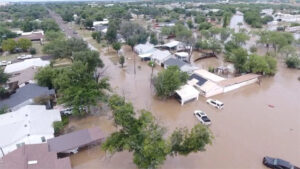 The Texas rains hadn’t even slowed before the debate began about why forecasts had underestimated the devastating flooding over Independence Day weekend.
The Texas rains hadn’t even slowed before the debate began about why forecasts had underestimated the devastating flooding over Independence Day weekend.
Local and state officials, social media users and even the meteorology community raised questions. What were the National Weather Service forecasts? Why is it so hard to know where rain will fall? Did staff reductions at the weather service and other budget cuts by the Trump administration contribute to the catastrophe? What role did weather balloons play in the storm forecasts?
Answers to some of these questions and many others may never be adequately answered, especially for the families of dozens of children swept away by floodwaters.
At least 81 people died between July 4 and 6 and dozens more were injured or remain missing, state officials said. On a weekend when families often celebrate with cookouts and fireworks, these families, overwhelmed with grief, were providing DNA samples so a state laboratory could rapidly identify victims.
A series of circumstances, colliding at the worst possible location and time, caused the tremendous flooding, several meteorologists told USA TODAY. During a July 6 news conference, Texas state officials said there would be much to discuss in the weeks ahead.
A few things are known, including how difficult it remains to pinpoint where thunderstorms will drop their heaviest rain, what the weather service said and when, and staffing levels at two local forecast offices.
The horrific tragedy arrived amid a maelstrom already brewing over the weather service, its parent agency and the Trump administration’s budget cuts.
It’s “clear that many people are allowing their desire to score political points to color their insights and opinions on this tragedy,” Alan Gerard, who retired earlier this year from the National Severe Storms Laboratory, wrote in his Substack blog on July 6.
“The National Weather Service office did everything they should do from everything I can tell,” said Jeff Masters, co-founder of Weather Underground, a commercial forecasting agency, and a former hurricane scientist with the NOAA Hurricane Hunters.
Despite the recent cuts to the National Oceanic and Atmospheric Administration, the weather service performed well in the Texas tragedy and the recent deadly flooding in Kentucky, Masters said. “It reminds us how important it is to have talented, experienced people at a well-funded National Weather Service.”
“But we are pushing our luck,” he noted,” if we think the cuts at NOAA won’t cause a breakdown in our ability to get people out of harm’s way in the future.
Although the warnings arrived less than 24 hours before the flooding started, long-time weather service veterans and regional experts say that’s not all that unusual in this region. It’s a known shortcoming of the localized rain models forecasters use. They can’t yet pinpoint exactly where intense rain might fall and when in an individual community.
One expert, Texas State Climatologist John Nielsen-Gammon, said it appears the weather service employees in Austin/San Antonio did what they could, based on the available information.
“From what I saw, the warnings were pretty timely,” said Nielsen-Gammon, a meteorology professor at Texas A&M University.
The weather service office first advised on July 1 and 2 that a very moist air mass was moving in that would increase rain chances across south-central Texas with heavy rain at times that could lead to minor local flooding.An early morning forecast on July 3 by the weather service’s Weather Prediction Center said the region should expect “unseasonably moist” air that could bring 1 to 2 inches of rain an hour and lead to flooding, with approaching storms tapping into abundant tropical moisture.
As the day progressed, a clearer picture emerged of how weather systems were interacting above Texas to form storms. An “urgent” flood watch at 1:18 p.m. on July 3 warned heavy rain, with isolated amounts of 5 to 7 inches, could cause flash flooding and “excessive” runoff that could flood rivers and streams. The watch covered eight counties, including Kerr and Bandera, where some of the heaviest flooding occurred.
By 7:02 p.m., the weather prediction center warned that leftover bits of Tropical Storm Barry, near-record moisture and an unstable atmosphere meant any storms that formed could be self-sustaining, with a potential for rain rates of more than 3 inches an hour, and they could rain over the same area again and again. It stated: “Considerable flash flooding this evening is possible.”
A flurry of forecast updates continued.
At 1:14 a.m. on July 4, the weather service issued a “Flash Flood Warning” for central Kerr County and northwestern Bandera County. Almost simultaneously, water flow began increasing dramatically on the Guadalupe River at Hunt, Texas.
“This pleasing stream had a flow rate of 53 gallons per second at midnight on July 4,” said Nielsen-Gammon. At 3 a.m., it was flowing at 264 gallons per second. Between 3 a.m. and 3:30 a.m., the water flow jumped to 125,000 gallons per second. Within four hours of the initial rise, the river level jumped 21.8 feet and was flowing at 900,000 gallons per second.
President Donald Trump campaigned on cutting the federal bureaucracy and reducing the budget. His administration, including the Office of Management and Budget and the Department of Governmental Efficiency, has been mission-focused on doing so.
The sweeping cuts left many federal offices short-staffed and demoralized, according to recent retirees.
Many remaining employees, including those who declined to speak on the record for fear of retribution, say employees still fear more jobs will be lost in a reduction in force. Federal agencies were required to prepare a plan for making further reductions, but a federal judge in California ruled in May that the job cuts could not move forward.
The weather service office in Austin/San Antonio oversees much of the Hill Country area where the flooding took place. Of the 26 staff positions in that office, six are vacant at the moment, including two senior members, said Victor Murphy, a recently retired weather service meteorologist in Texas. One of those is the warning coordination meteorologist who oversees emergency warnings and works with local officials on communicating around such events.
The Austin office is also short two forecasters.
Did the cuts play any role in the recent tragedy? Murphy wondered out loud. “I don’t know … The fact is that the office had record flooding two days in a row.”
The San Angelo, Texas, office is down four positions, including a staff forecaster, a lead hydrologist and its meteorologist in charge, said Tom Fahy, legislative director for the National Weather Service Employees Organization.
Weather service forecasters often become “an easy target for people’s wrath,” when people are looking for someone to blame, Fahy said.
“The real blame is the Trump Administration budget cuts to NWS and FEMA that cut off coordination planning with local emergency management officials,” he said. “Even during Trump’s first term, NWS managers would plan, practice and train their combined teams for increased cooperation. All that ended when Trump was inaugurated in 2025.”
Trump said July 6 that he doesn’t think the federal government needs to rehire weather service meteorologists in the wake of catastrophic Texas flooding.
“I would think not,” Trump told reporters when asked about rehiring weather forecasters, adding that flooding “happened in seconds. Nobody expected it.”
When asked if he would investigate whether the cuts left key vacancies in the weather service or emergency coordination, Trump said he “wouldn’t blame (former President Joe) Biden for it either. I would just say this is a 100-year catastrophe, and it’s just so horrible for all.”
At a news conference on July 5, Nim Kidd, chief of the Texas Division of Emergency Management, said: “The original forecast that we received on Wednesday from the National Weather Service predicted 3 to 6 inches of rain in the Concho valley and 4 to 8 inches in the Hill Country.”
“The amount of rain that fell in this specific location was never in any of those forecasts,” Kidd said.
Rainfall estimates in these extreme rainfall events have fallen short before, frustrating emergency managers, forecasters and even members of Congress, who approved measures in 2021 and 2022 to improve rainfall modeling and estimates of maximum possible precipitation within any given time frame.
As the weather service looked at their computers on July 3, the models they use for forecasting thunderstorms wouldn’t come together with a consensus on where the greatest rain would fall, according to their discussions. Many showed the potential for extreme rainfall somewhere in central Texas, while others showed almost nothing happening, Nielsen-Gammon said. “Where it was going to develop would depend on the details of the individual thunderstorms that popped up.”
Pinpointing localized extreme rain remains “a very difficult challenge,” Gerard said. Any time you have this type of environment, there’s going to be a chance that local areas are going to get more rain than anticipated.”
Rainfall in a storm is “controlled by very small-scale processes that are happening within the storm,” said Gerard, now CEO of weather consulting company Balanced Weather. “We don’t have the resolution of modeling to be able to forecast that yet.”
The storms laboratory is working to develop higher resolution modeling, he said, but it’s on the chopping block in the president’s proposed budget.
Weather balloon launches measure moisture up through the atmosphere to help predict how much is available for rain. The better the data, the better the outcome, said Murphy, the recently retired Texas meteorologist. “You find out from a sounding what’s up 20,000, 30,000, or 40,000 feet. The only way to measure that is with a balloon.”
However, staffing shortages at local weather service offices across the United States have forced the limiting or cancellation of numerous weather balloon launches. Of 11 locations in Texas and surrounding states that were launching in the early spring, only six of the sites now launch balloons on any given morning, Murphy said.
There was only one weather balloon launch within 200 miles of the flooded area, Nielsen-Gammon said.
However, that one weather balloon proved its worth, the experts said, providing essential information that helped weather service forecasters see the increased chances for rain.
Launched remotely from an automated site in Del Rio, Texas, Murphy said it’s “the only one of its kind in the region.”
But the federal cutbacks and rising number of climate disasters mean the public is likely to blame someone for every botched forecast and missed opportunity to warn ‒ whether deservedly or not.
On July 7, White House Press Secretary Karoline Leavitt defended the president and the weather service’s performance.
“Blaming President Trump for these floods is a depraved lie and it serves no purpose during this time of national mourning,” Leavitt said. “The National Weather Service did its job.”
